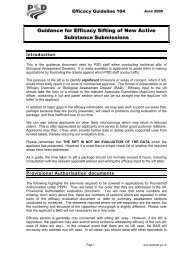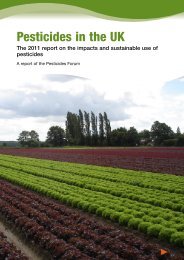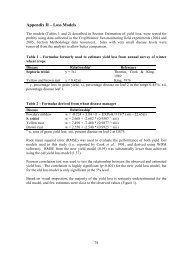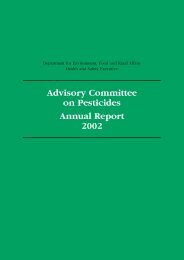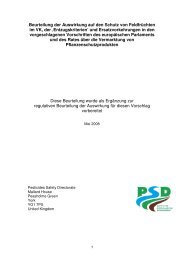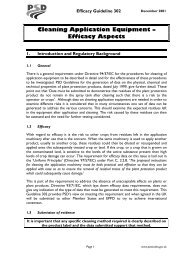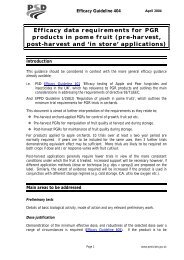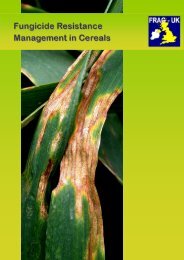Advisory Committee on Pesticides Annual Report 2001
ACP Annual Report 2001 - Pesticides Safety Directorate
ACP Annual Report 2001 - Pesticides Safety Directorate
You also want an ePaper? Increase the reach of your titles
YUMPU automatically turns print PDFs into web optimized ePapers that Google loves.
<str<strong>on</strong>g>Advisory</str<strong>on</strong>g> <str<strong>on</strong>g>Committee</str<strong>on</strong>g> <strong>on</strong> <strong>Pesticides</strong> <strong>Annual</strong> <strong>Report</strong> <strong>2001</strong><br />
Members supported several c<strong>on</strong>firmatory data requirements proposed for<br />
inclusi<strong>on</strong> of propoxycarbaz<strong>on</strong>e-sodium in Annex I.<br />
Pyraclostrobin<br />
Pyraclostrobin (BAS 500F) is a new strobilurin fungicide. The ACP c<strong>on</strong>sidered<br />
an applicati<strong>on</strong> for use of ‘BAS 500 01F’ (trade name ‘Comet’), an emulsifiable<br />
c<strong>on</strong>centrate formulati<strong>on</strong> for c<strong>on</strong>trol of a range of fungal diseases in wheat,<br />
barley, oats, rye and triticale. The active substance is also being c<strong>on</strong>sidered<br />
for inclusi<strong>on</strong> in Annex I of Directive 91/414/EEC with Germany acting<br />
as Rapporteur Member State.<br />
‘BAS 500 01F’ was classified <strong>on</strong> the basis of toxicological properties as<br />
‘Harmful if swallowed and by inhalati<strong>on</strong>’ and ‘Irritating to skin’. An ADI of<br />
0.03 mg/kg bw/day was derived from the NOAEL of 3.4 mg/kg bw/day in<br />
a two-year rat chr<strong>on</strong>ic toxicity and carcinogenicity study. The NOAEL was<br />
based <strong>on</strong> reduced food efficiency and bodyweight gain, and liver cell<br />
necrosis in males.<br />
22<br />
An ARfD of 0.05 mg/kg bw/day was established based <strong>on</strong> a NOAEL of<br />
5 mg/kg bw/day from a rabbit developmental study, with reduced food<br />
c<strong>on</strong>sumpti<strong>on</strong> after gavage dosing at higher levels (this was the <strong>on</strong>ly acute<br />
systemic effect that could be identified as relevant for setting the ARfD).<br />
The residue profile was c<strong>on</strong>sidered to have been adequately addressed.<br />
Estimates of c<strong>on</strong>sumer intakes (from both chr<strong>on</strong>ic exposure and acute<br />
exposure over a single day) were well below the ADI and ARfD. An MRL<br />
of 0.2 mg/kg, based <strong>on</strong> the residue definiti<strong>on</strong> of parent pyraclostrobin,<br />
was c<strong>on</strong>sidered appropriate for wheat, barley and oats.<br />
A short-term systemic AOEL of 0.03 mg/kg bw/day was derived from a<br />
NOAEL in a 90-day dog study of 5.8 mg/kg bw/day based <strong>on</strong> hypertrophy<br />
of the duodenum in both sexes and bodyweight loss in females. The AOEL<br />
allowed for a 100-fold assessment factor. Estimated exposure to pyraclostrobin,<br />
arising from the use of ‘BAS 500 01F’, assuming gloves were worn when<br />
handling the c<strong>on</strong>centrate, was within the AOEL and thus c<strong>on</strong>sidered<br />
acceptable to operators, bystanders and other workers.<br />
The presence of minor phytotoxic effects combined with evidence of<br />
damage to some plants, including maize, in glasshouse screens meant that<br />
extrapolati<strong>on</strong> to rye or triticale could not be accepted without some<br />
c<strong>on</strong>firmatory data <strong>on</strong> the safety of ‘BAS 500 01F’ to these crops. Therefore<br />
it was recommended claims for use <strong>on</strong> these crops should be deleted from<br />
the label.




